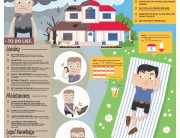December 14, 2012
Embracing a more environmentally conscious way of living brings benefits not only to your bottom line but to the environment and greater community as a whole. Not just a fad, its becoming increasingly obvious that the more people who join in on carrying out the small tasks and actions that constitute a green living, the more the green revolution is here to stay. So what are you waiting for to adopt the easy, small things you can do to help save the environment? Even a minimal change in your daily habits will make a tremendous difference in the long run.
What you have to do first is to look around your home, apartment or condo and evaluate what you can do to practice the 3 R’s – Reduce, Reuse and Recycle. Once you do, you will realize that going green is really quite simple. For every plastic bag that you refuse to use, for every aluminum can that you toss in the recycle bin and for every carpool that you decide to take part in can go a long way to creating change.
Here are some simple steps that you can do to create change that starts from the home.
- Make sure that all home appliances and equipment is turned off when not being used. Because some electronic equipment and appliances (your television, computer, toaster, microwave, etc) still use electricity when turned off, it is a good idea to turn off and unplug electrical appliances that you are not using to increase efficiency even more.
- Replace your incandescent light bulbs with energy efficient CFL (compact fluorescent light bulbs). These use much less energy and lasts 10 times longer according to the US Environmental Protection Agency. Be sure to always dispose of your burned out light bulbs properly. When in doubt, contact your local recycling facility so that they can direct you where to go.
- Cut down on the use of plastic bags. Use a reusable shopping bag when going to the grocery store. It’s a good idea to keep a few of these reusable shopping bags in your car so that you don’t end up using grocery store plastic bags, for which you must pay an additional fee.
- Set your thermostat at a low temperature. According to the US Department of Energy, turning your thermostat back 10-15 degrees for eight hours a day can save an individual an estimated 10% a year on heating and cooling bills. In the winter, set the thermostat to 68F when you’re awake and at home. Set it lower while you’re asleep or not at home. In the summer, adopt the same strategy with central air conditioning – turn off the air conditioning when you’re away and lower the thermostat setting to 78F when you’re at home.
- When purchasing new appliances, look for the “Energy Star” logo, which is a hallmark of the US Department of Energy and the EPA. “Energy Star” logo products are considerably more energy-efficient than non-logo appliances.










